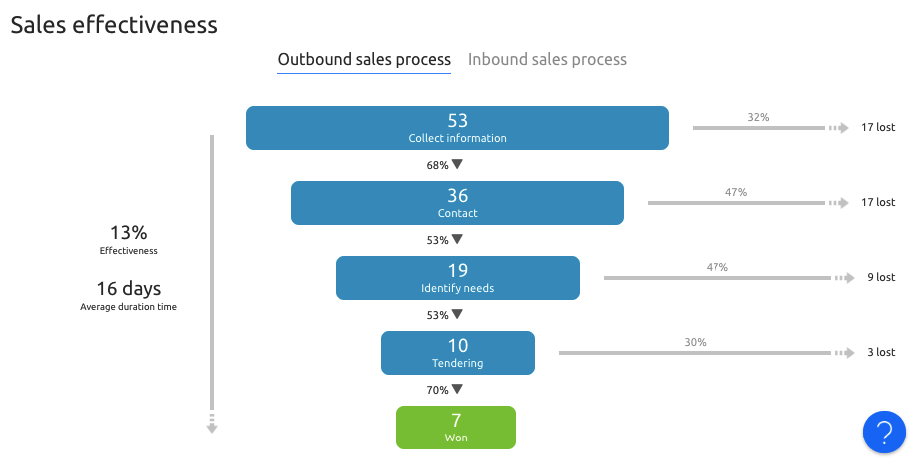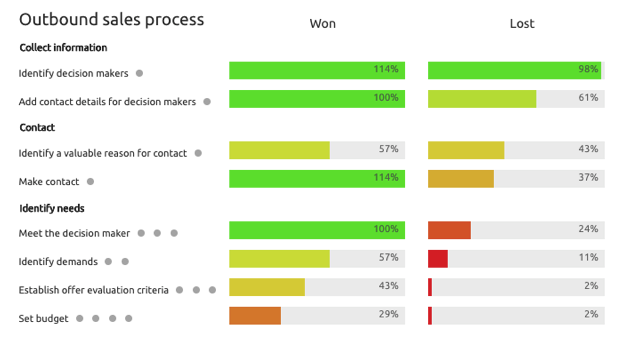5 Ways Defining Your Sales Process Can Benefit Your Business
Graham Richardson
Be honest… How well do you know ‘your’ sales process? And could you write down each stage, step and action if asked? A well-defined sales process is crucial in helping your business grow…
Sales are rarely sequential. There will be setbacks.
Which means you will need to go back to an earlier stage and adapt.
A well-defined sales process will allow users to track their customers’ journey, identify any risks and patterns along the way, and in-time, help you learn which steps are most likely to encourage prospects down the sales funnel.
No doubt you will have heard the term ‘sales process’, and in one way or another, we have been subject to it, either as a consumer or as a salesperson.
If you run a search for ‘sales process’ online, you’ll have dozens of helpful articles and best practices to sink your teeth into. Everything from detailed definitions, to the five, six, seven or even eight stages of creating a sales process.
But how well do you know ‘your’ sales process? Take a minute to asses:
Are you able to write down and define your sales process if asked?
Is your sales team able to do the same?
Are you able to distinguish the different stages, steps and actions for your different processes?
As software and sales tech stacks continue to improve and deliver faster, more scalable products, the importance of having your sales process (or processes) clearly mapped out and defined is vital.
Defining your sales process is crucial in helping your businesses grow. By eliminating much of the guesswork of managing leads and customers, smaller businesses can benefit massively from a defined sales process.
Clearly defined opportunities, at designated stages, allows team members to replace their guesswork with a series of easily observable phases, that can be tracked and measured across every stage of every process.
A well-defined process ensures all team members are fully aware of each stage of the sales process, the actions required along the way and what needs to be completed in order to progress to the next step.
And if that wasn’t reason enough to spend some time writing down and defining your sales processes, perhaps the points below will sway you to do so:
1. Better Revenue Predictions
If your sales process is repeatable, there must be an element of predictability at each stage. This predictability can be invaluable, as it will help you improve the accuracy of your forecasting and may well help in revenue prediction.
Knowing your ratios can prove vital in helping you achieve your targets, i.e. from 100 leads, how many convert to the prospect/trial stage, and how many of those convert to actual paying customers? Measuring results helps you recognize where your challenges lie, and likewise, where opportunities may exist.
2. Improve New Staff Onboarding
Once your process is clearly defined, bringing on new sales reps will be much easier. Team members will have a clearly defined system to help get them up to speed quickly. Putting processes in place that will help incorporate new starters into the team, aids in the ease of new employee onboarding.
After all, the best way to figure out what works and what doesn’t is to ask. After a new starters first week, sit down with them and ask them to give some honest feedback (i.e. what went well? what do they feel is lacking?).
Studies have shown that employees who feel that their company takes the time to invest in them will be more productive and ultimately, perform better for your business.
3. Identify Opportunities for Improvement
Your sales process is ever evolving – continuously being improved based on feedback and the results of your sales team. By inspecting and reviewing your sales process (and the results at the end of a particular campaign), you can see what happened at each stage of your sales funnel, and react accordingly – rather than at the final closing stage.
With regular review, one can learn to recognize patterns, areas of focus, training issues for sales teams, bottlenecks, or opportunities.
4. Save Time with Task Automation
When defining your process in your CRM, it’s also good practice to add in follow up tasks or required actions after each stage or step.
By automating your tasks and adding them into your sales process (i.e. when task A is completed, task B is automatically added to your CRM & calendar), you help ensure every step on your team’s process is mapped out, from adding tasks into calendars to completing key metrics or adding forecasts.
 5. Process Optimization
5. Process Optimization
Once you’ve built the right sales process and implemented tools to monitor it (most likely your CRM), you’ll finally be able to optimize it.
“If you can’t measure it, you can’t improve it.”
— Peter Drucker
Three simple and straightforward methods to help with your process optimization are;
i. A / B tests – divide your sales team into two groups, each group selling the same product or services, but with each following a different process. After some time, analyze the result and their effectiveness and choose the process that yielded the best results.
ii. Analysis of Activities – this involves observing how often certain activities in the sales process are performed and how it affects the winning or losing of deals, i.e. the percentage of deals won when a particular action is performed, versus the percentage lost when that same action is not performed. This is crucial in helping you understand which stage in the process has the most impact and which actions will ultimately lead to closure.
iii. Coaching – the most classic of methods. Simply put, in-depth interviews with your teams on how well the process works for them. It’s important to organize regular meetings where teams can discuss ideas for streamlining the process. If managing larger teams, or meeting one on one, it’s also worth bearing in mind your teams’ different learning styles and adapting your coaching method accordingly.
Any sales CRM system worth its salt should help you determine where each of your prospects fit within the B2B sales funnel, whether you need to refine the funnel for different prospects, or indeed whether you need to run multiple sales processes.
A B2B sales funnel hosted in a CRM system with hard numbers, leads and sales projections attached makes for a powerful tool in protecting and managing the growth of a company.
Not to mention, it’s far more actionable than an Excel spreadsheet. 🙂
So now you’ve defined your process and identified opportunities for improvement or development, it’s also important to consider:
Is one process enough?
Typically, there are several sales processes within one company. The situation may be different, for example, when someone contacts you directly to inquire about your services or product, to when you search, source and contact prospects yourself.
You may also create different processes for different products or services, or for different teams.
What’s next?
Creating and defining your first sales process or improving your current one is not overly difficult and brings with it, tangible benefits. I’d encourage all teams to experiment and initiate conversations within their company about their processes and how or where they may be improved. It does not matter if you work in a small or a large corporation, the principles are exactly the same.
Sales are rarely sequential. There will be setbacks, which will mean you will need to go back to an earlier stage and adapt. A well configured CRM will allow users to track their customers’ journey, identify any risks and patterns along the way, and in-time, help you learn which steps are most likely to encourage prospects down the sales funnel.
A clearly defined process is vital in helping you ensure effective, repeatable & scalable results. For a deeper dive into implementing these processes, check out our definitive guide to sales process implementation for managers.
Not sure how or where to start in defining your process? Contact us and find out how our B2B sales CRM can help.
Other posts

Sales Metrics & KPIs You Should Measure to Track Your Sales Performance

What are the differences between coaching, mentoring, training, and consulting?









 5. Process Optimization
5. Process Optimization